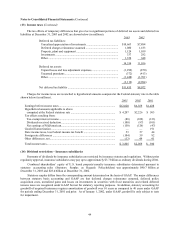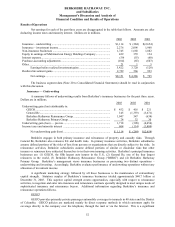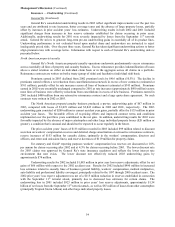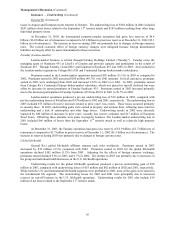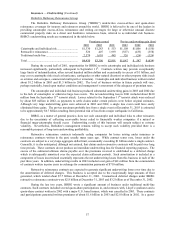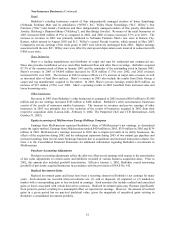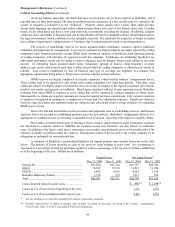Berkshire Hathaway 2003 Annual Report Download - page 55
Download and view the complete annual report
Please find page 55 of the 2003 Berkshire Hathaway annual report below. You can navigate through the pages in the report by either clicking on the pages listed below, or by using the keyword search tool below to find specific information within the annual report.
54
Management’s Discussion (Continued)
Insurance — Underwriting (Continued)
General Re (Continued)
General Re’ s consolidated underwriting results in 2003 reflect significant improvements over the past two
years and are attributed to rate increases, better coverage terms and the absence of large property losses, partially
offset by increases in prior accident years’ loss estimates. Underwriting results in both 2002 and 2001 included
significant charges from increases in loss reserve estimates established for claims occurring in prior years.
Additionally, underwriting results for 2001 were severely impacted by losses from the September 11th terrorist
attack. General Re strives to generate long-term pre-tax underwriting gains in essentially all of its product lines.
Underwriting performance is not evaluated based upon market share and underwriters are instructed to reject
inadequately priced risks. Over the past three years, General Re has taken significant underwriting actions to better
align premium rates with coverage terms. Information with respect to each of General Re’ s underwriting units is
presented below.
North American property/casualty
General Re’ s North American property/casualty operations underwrite predominantly excess reinsurance
across essentially all lines of property and casualty business. Excess reinsurance provides indemnification of losses
above a stated retention on either an individual claim basis or in the aggregate across all claims in a portfolio.
Reinsurance contracts are written on both a treaty (group of risks) and facultative (individual risk) basis.
Premiums earned in 2003 declined from 2002 premium levels by $416 million (10.5%). The decline in
premiums earned reflects a net reduction from cancellations/non-renewals in excess of new contracts (estimated at
$761 million), partially offset by rate increases across all lines of business (estimated at $345 million). Premiums
earned in 2002 were essentially unchanged compared to 2001 as rate increases (approximately $800 million) across
most lines of business were offset by reductions from cancellations in excess of new business. Premiums earned in
2001 included $400 million from one retroactive reinsurance contract and a large quota share agreement. No such
contracts were written in 2002 or 2003.
The North American property/casualty business produced a pre-tax underwriting gain of $67 million in
2003, compared with losses of $1,019 million and $2,843 million in 2002 and 2001, respectively. The 2003
underwriting gain consisted of $200 million in current accident year gains, partially offset by $133 million in prior
accident year losses. The favorable effects of re-pricing efforts and improved contract terms and conditions
implemented over the past three years contributed to the net gain. In addition, underwriting results for 2003 were
favorably impacted by the absence of major catastrophes and other large individual property losses ($20 million or
greater), a condition that is unusual and should not be expected to occur regularly in the future.
The prior accident years’ losses of $133 million recorded in 2003 included $99 million related to discount
accretion on workers’ compensation reserves and deferred charge amortization on retroactive reinsurance contracts,
reserve increases of $153 million for casualty claims, (primarily in the workers’ compensation, directors and
officers, and errors and omissions lines), and reserve decreases of $119 million for property claims.
For statutory and GAAP reporting purposes workers’ compensation loss reserves are discounted at 1.0%
per annum for claims occurring after 2002 and at 4.5% for claims occurring before 2003. The lower discount rate
for 2003 claims was approved by General Re’ s state insurance regulators and reflects the lower interest rate
environment that now exists. The lower discount rate effectively reduced 2003 underwriting gains by
approximately $74 million.
Underwriting results for 2002 included $1,085 million in prior year loss reserve adjustments, offset by net
gains of $66 million with respect to the 2002 accident year. Results for 2002 included $990 million in increased
loss estimates related to casualty lines of business (general liability, workers’ compensation, medical malpractice,
auto liability and professional liability coverages), principally related to the 1997 through 2000 accident years. The
2002 prior years’ loss reserve adjustment was net of a $115 million reduction in reserves established in connection
with the September 11th terrorist attack, primarily due to decreased loss estimates for certain claims. The
underwriting loss in 2001 included $923 million in prior years’ loss reserve adjustments, approximately $1.54
billion of net losses from the September 11th terrorist attack, as well as $87 million of losses from other catastrophes
(principally Tropical Storm Allison) and other large individual property losses.


